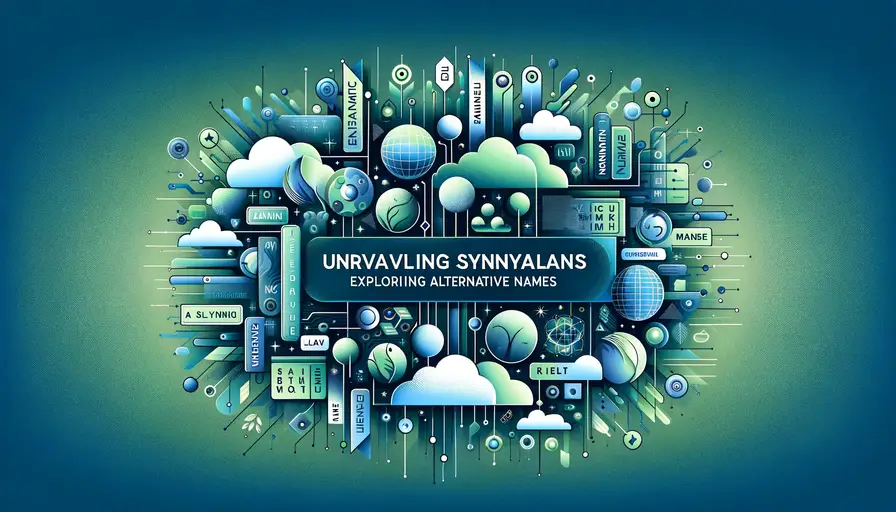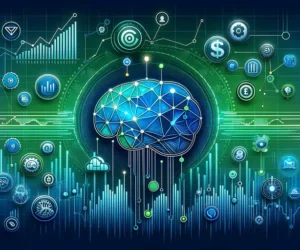
Unraveling Synonyms for Machine Learning: Exploring Alternative Names

Machine learning is a rapidly evolving field that intersects with various domains, leading to the creation of numerous terms and synonyms. These alternative names often capture different aspects or applications of machine learning, providing a richer vocabulary for researchers, practitioners, and enthusiasts. This article explores various synonyms for machine learning, delving into their meanings, applications, and nuances.
- Artificial Intelligence: The Broad Umbrella
- Data Science: The Interdisciplinary Field
- Predictive Analytics: Focusing on Predictions
- Machine Learning: The Core Technology
- Deep Learning: The Power of Neural Networks
- Cognitive Computing: Mimicking Human Thought
- Statistical Learning: The Foundation of ML
Artificial Intelligence: The Broad Umbrella
Understanding Artificial Intelligence
Artificial Intelligence (AI) is the broad umbrella under which machine learning falls. AI refers to the simulation of human intelligence in machines designed to think and learn like humans. It encompasses a wide range of subfields, including machine learning, natural language processing, robotics, and computer vision.
AI aims to create systems capable of performing tasks that typically require human intelligence, such as recognizing speech, making decisions, and translating languages. The term "AI" is often used interchangeably with machine learning, but it is essential to note that machine learning is just one approach to achieving AI.
For example, AI includes expert systems that use predefined rules to mimic human decision-making processes. Unlike machine learning, which learns from data, these systems rely on human expertise encoded in rule-based systems.
Improving NLP Model RobustnessThe Evolution of AI
AI has undergone significant evolution since its inception. Early AI systems were rule-based and limited in their capabilities. With the advent of machine learning, AI systems became more flexible and powerful, capable of learning from vast amounts of data. This shift marked a transition from "narrow AI," designed for specific tasks, to more general AI applications.
Modern AI applications leverage machine learning algorithms to improve their performance over time. Examples include self-driving cars, personal assistants like Siri and Alexa, and recommendation systems used by platforms like Netflix and Amazon.
AI in Everyday Life
AI is increasingly integrated into everyday life, making various technologies more intelligent and user-friendly. From voice-activated assistants to smart home devices, AI enhances user experiences by providing more personalized and efficient interactions.
For instance, AI-driven chatbots on websites help users navigate services and find information quickly. These chatbots use natural language processing to understand and respond to user queries, demonstrating AI's practical applications.
Choosing Neural Networks over ML: Making the Right DecisionData Science: The Interdisciplinary Field
What is Data Science?
Data Science is an interdisciplinary field that combines statistical analysis, computer science, and domain expertise to extract insights from data. It involves various processes, including data collection, cleaning, analysis, and visualization. Machine learning is a critical component of data science, providing tools and techniques for building predictive models.
Data scientists use machine learning algorithms to analyze large datasets and uncover patterns that inform decision-making. The insights gained from data science can drive business strategies, optimize operations, and enhance product development.
For example, a data scientist might use machine learning to analyze customer data and predict purchasing behavior. These predictions can then be used to tailor marketing campaigns and improve customer engagement.
Key Components of Data Science
Data science involves several key components, each playing a vital role in the overall process. These components include data collection, where raw data is gathered from various sources; data cleaning, which involves preprocessing and transforming the data to ensure quality; and data analysis, where statistical and machine learning techniques are applied to extract insights.
Exploring Machine Learning Without R: Breaking Down the BasicsData visualization is another crucial aspect of data science. It involves presenting data in graphical formats, such as charts and graphs, making it easier for stakeholders to understand and interpret the results. Tools like Tableau, Power BI, and Matplotlib are commonly used for data visualization.
Applications of Data Science
Data science has a wide range of applications across different industries. In healthcare, data science is used to analyze patient data and develop predictive models for disease diagnosis and treatment. In finance, it helps in risk management, fraud detection, and algorithmic trading.
Retailers use data science to optimize inventory management and personalize customer experiences. For example, companies like Kaggle host data science competitions where participants use machine learning to solve real-world problems, showcasing the diverse applications of data science.
Predictive Analytics: Focusing on Predictions
Defining Predictive Analytics
Predictive Analytics is a branch of advanced analytics that uses historical data, statistical algorithms, and machine learning techniques to predict future outcomes. It focuses on identifying patterns in data and using them to make informed predictions about future events.
Can Machine Learning Emulate Human Rage?Predictive analytics is widely used in various fields, including finance, marketing, healthcare, and manufacturing. By analyzing past data, businesses can anticipate trends, identify risks, and make proactive decisions.
For instance, in finance, predictive analytics can forecast stock prices or assess credit risk. In marketing, it can predict customer churn and identify the most effective promotional strategies.
Techniques in Predictive Analytics
Predictive analytics employs several techniques to generate accurate predictions. These techniques include regression analysis, which models the relationship between variables; classification algorithms, which categorize data into predefined classes; and clustering, which groups similar data points together.
Time series analysis is another important technique in predictive analytics. It involves analyzing data points collected or recorded at specific time intervals to forecast future values. Tools like ARIMA and Prophet are commonly used for time series forecasting.
Using Machine Learning: Assessing Suitability and LimitationsReal-World Applications
Predictive analytics has numerous real-world applications that drive business value. In the retail industry, predictive analytics helps optimize pricing strategies and manage inventory levels. By predicting demand patterns, retailers can ensure that products are available when customers need them, reducing stockouts and excess inventory.
In healthcare, predictive analytics can improve patient outcomes by predicting disease outbreaks and identifying high-risk patients. For example, predictive models can analyze patient data to forecast the likelihood of readmission, enabling healthcare providers to take preventive measures.
Machine Learning: The Core Technology
Understanding Machine Learning
Machine Learning (ML) is the core technology behind many AI applications. It involves training algorithms to learn from data and make predictions or decisions without being explicitly programmed. Machine learning can be categorized into three main types: supervised learning, unsupervised learning, and reinforcement learning.
Supervised learning involves training a model on labeled data, where the correct output is known. The model learns to map inputs to outputs and can make predictions on new, unseen data. Examples include classification and regression tasks.
Dominant Machine Learning Algorithm for ANNUnsupervised learning, on the other hand, deals with unlabeled data. The model tries to find hidden patterns or structures within the data. Clustering and association are common unsupervised learning tasks.
The Role of Algorithms
Machine learning relies on various algorithms to perform different tasks. Common algorithms include linear regression for predicting continuous values, decision trees for classification and regression, k-means clustering for grouping data points, and neural networks for complex pattern recognition.
Each algorithm has its strengths and weaknesses, making it suitable for specific types of problems. For example, decision trees are easy to interpret but can overfit on noisy data. Neural networks, while powerful, require large datasets and significant computational resources.
Practical Implementation
Implementing machine learning involves several steps, from data preparation to model evaluation. Tools like scikit-learn, TensorFlow, and PyTorch provide a comprehensive framework for building and deploying machine learning models.
Here is an example of implementing a simple machine learning model using scikit-learn:
import pandas as pd
from sklearn.model_selection import train_test_split
from sklearn.linear_model import LogisticRegression
from sklearn.metrics import accuracy_score
# Load dataset
data = pd.read_csv('data.csv')
X = data.drop('target', axis=1)
y = data['target']
# Split data into training and testing sets
X_train, X_test, y_train, y_test = train_test_split(X, y, test_size=0.2, random_state=42)
# Train the model
model = LogisticRegression()
model.fit(X_train, y_train)
# Make predictions
predictions = model.predict(X_test)
# Evaluate the model
accuracy = accuracy_score(y_test, predictions)
print(f"Model Accuracy: {accuracy}")This code demonstrates how to load data, train a logistic regression model, and evaluate its accuracy using scikit-learn.
Deep Learning: The Power of Neural Networks
What is Deep Learning?
Deep Learning is a subset of machine learning that focuses on neural networks with many layers (hence "deep"). These networks, known as deep neural networks, can learn complex patterns in large amounts of data, making them suitable for tasks such as image recognition, natural language processing, and speech synthesis.
Deep learning models are inspired by the human brain's structure and function, with neurons and synapses forming layers that process information. Each layer in a neural network extracts increasingly abstract features from the input data.
Architectures of Deep Neural Networks
Deep learning models come in various architectures, each designed for specific types of tasks. Common architectures include Convolutional Neural Networks (CNNs) for image processing, Recurrent Neural Networks (RNNs) for sequential data, and Generative Adversarial Networks (GANs) for generating new data.
CNNs use convolutional layers to detect features such as edges and textures in images, making them highly effective for tasks like object detection and image classification. RNNs, with their ability to retain information across time steps, are well-suited for language modeling and time series prediction.
Building a Deep Learning Model
Building a deep learning model involves defining the network architecture, training it on data, and fine-tuning hyperparameters. Libraries like TensorFlow and Keras simplify this process by providing high-level APIs for constructing and training neural networks.
Here is an example of building a simple deep learning model using Keras:
from keras.models import Sequential
from keras.layers import Dense
from keras.optimizers import Adam
import numpy as np
# Generate dummy data
X_train = np.random.random((1000, 20))
y_train = np.random.randint(2, size=(1000, 1))
# Define the model
model = Sequential()
model.add(Dense(64, input_dim=20, activation='relu'))
model.add(Dense(1, activation='sigmoid'))
# Compile the model
model.compile(optimizer=Adam(), loss='binary_crossentropy', metrics=['accuracy'])
# Train the model
model.fit(X_train, y_train, epochs=10, batch_size=32)
# Evaluate the model
accuracy = model.evaluate(X_train, y_train)[1]
print(f"Model Accuracy: {accuracy}")This code demonstrates how to define, compile, and train a simple deep learning model using Keras.
Cognitive Computing: Mimicking Human Thought
Defining Cognitive Computing
Cognitive Computing refers to systems that mimic human thought processes to solve complex problems. These systems use machine learning, natural language processing, and reasoning to understand and respond to unstructured data. Cognitive computing aims to enhance human decision-making by providing insights and recommendations based on vast amounts of data.
Cognitive computing systems can understand context, recognize patterns, and learn from interactions, making them suitable for tasks that require human-like intelligence. Examples include virtual assistants, chatbots, and recommendation systems.
Applications of Cognitive Computing
Cognitive computing has a wide range of applications across different industries. In healthcare, cognitive systems analyze patient data to assist in diagnosis and treatment planning. In finance, they help detect fraud and manage risk by analyzing transaction patterns and market trends.
Retailers use cognitive computing to personalize customer experiences by analyzing purchase history and preferences. For instance, cognitive systems can recommend products based on a customer's past behavior, enhancing customer satisfaction and loyalty.
Building Cognitive Applications
Building cognitive applications involves integrating various AI technologies to create systems that can reason, learn, and interact naturally with humans. Tools like IBM Watson provide platforms for developing cognitive applications, offering APIs for natural language understanding, speech-to-text, and image recognition.
Here is an example of building a simple cognitive application using IBM Watson:
import json
from ibm_watson import AssistantV2
from ibm_cloud_sdk_core.authenticators import IAMAuthenticator
# Set up IBM Watson Assistant
authenticator = IAMAuthenticator('your_api_key')
assistant = AssistantV2(
version='2021-06-14',
authenticator=authenticator
)
assistant.set_service_url('your_service_url')
# Create a session
session_id = assistant.create_session(
assistant_id='your_assistant_id'
).get_result()['session_id']
# Send a message to the assistant
response = assistant.message(
assistant_id='your_assistant_id',
session_id=session_id,
input={
'message_type': 'text',
'text': 'Hello, how can I help you today?'
}
).get_result()
# Print the response
print(json.dumps(response, indent=2))This code demonstrates how to set up and interact with IBM Watson Assistant, creating a simple cognitive application.
Statistical Learning: The Foundation of ML
What is Statistical Learning?
Statistical Learning is the foundation of many machine learning techniques. It involves understanding data through statistical models, which capture relationships between variables. Statistical learning provides the theoretical framework for many machine learning algorithms, offering insights into their behavior and performance.
Key concepts in statistical learning include hypothesis testing, confidence intervals, and regression analysis. These concepts help quantify the uncertainty in predictions and assess the reliability of models.
Techniques in Statistical Learning
Statistical learning encompasses various techniques, including linear regression, logistic regression, and Bayesian inference. These techniques are used to model relationships between variables, estimate parameters, and make predictions.
Linear regression, for example, models the relationship between a dependent variable and one or more independent variables using a linear equation. Logistic regression, on the other hand, models the probability of a binary outcome based on predictor variables.
Practical Applications
Statistical learning techniques are widely used in various fields, from economics and finance to biology and engineering. In economics, regression models are used to analyze the impact of different factors on economic indicators such as GDP and inflation. In finance, statistical models help assess investment risks and predict stock prices.
In biology, statistical learning aids in understanding genetic data and modeling biological processes. For example, researchers use regression models to identify genes associated with diseases, contributing to the development of personalized medicine.
Here is an example of implementing a linear regression model using scikit-learn:
import pandas as pd
from sklearn.model_selection import train_test_split
from sklearn.linear_model import LinearRegression
from sklearn.metrics import mean_squared_error
# Load dataset
data = pd.read_csv('data.csv')
X = data.drop('target', axis=1)
y = data['target']
# Split data into training and testing sets
X_train, X_test, y_train, y_test = train_test_split(X, y, test_size=0.2, random_state=42)
# Train the model
model = LinearRegression()
model.fit(X_train, y_train)
# Make predictions
predictions = model.predict(X_test)
# Evaluate the model
mse = mean_squared_error(y_test, predictions)
print(f"Model MSE: {mse}")This code demonstrates how to implement a linear regression model using scikit-learn, showcasing the practical application of statistical learning.
Exploring the various synonyms and related fields of machine learning, such as artificial intelligence, data science, predictive analytics, deep learning, cognitive computing, and statistical learning, provides a comprehensive understanding of the landscape. Each term highlights a different aspect of how machines can learn from data and make intelligent decisions, contributing to the advancement of technology and its applications in the real world.
By understanding these alternative names and their specific nuances, you can better appreciate the depth and breadth of machine learning and its impact across various domains. Whether you are a researcher, practitioner, or enthusiast, this knowledge will enhance your ability to navigate and contribute to the ever-evolving field of machine learning.
If you want to read more articles similar to Unraveling Synonyms for Machine Learning: Exploring Alternative Names, you can visit the Artificial Intelligence category.



You Must Read